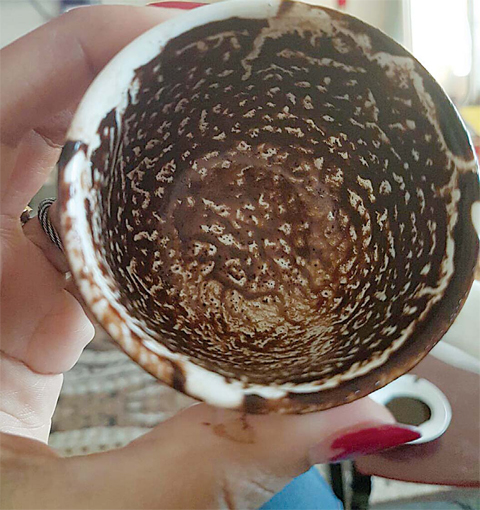Tasseography is the practice of reading tea leaves or coffee grounds for the purpose of fortune telling. Illegal in Kuwait, it is often practiced for 'fun' with a focus on personality traits and past events rather than the future.
 .
.Two lines on the top of my cup symbolize hands praying to God, according to Marwa, a coffee ground reader who does it "just for fun". In fact, most of what she told me about previous events was correct. She didn't say much about the future, which I anyways wouldn't have believed.
Tea leaf or coffee ground reading is a kind of fortunetelling, in addition to telling personal situations or events that happened in the past. Known as tasseography, it is done after turning a small-sized cup upside-down on its saucer after drinking Turkish coffee, with the residual coffee grounds remaining in the cup. Various patterns appear on the surface of the cup symbolizing events from the future, past or even the present time.
Tasseography isn't popular in Kuwait as its most often done with Turkish coffee, which is not a traditional drink here. But among Arab expats, the practice continues, though only for fun.
Cup reading is a hobby for 31-year-old Marwa. "I don't get paid for it. I'm doing it for fun and I only read for my friends and colleagues. I have received positive feedback from them, and they almost always they tell me that what I read for them out of their cup is true," she told Kuwait Times. Some excerpts:
Kuwait Times: Who taught you cup reading?
Marwa: I learned from my maternal grandmother about 10 years ago, as this ritual is very popular and important in our community in Egypt.
KT: Do you believe what you see in the cup? And do your friends believe it?
Marwa: I believe what appears in the cup, otherwise I wouldn't be doing it. I guess they do too, although some of them say they don't believe in events related to the future, as it's haram in Islam to try and predict the future. I read about the past or situations happening to the person in the present time. I never hide anything I see and always tell them the truth, even if it seems bad.
KT: Do you read your own cup?
Marwa: No I don't read for myself - I think I may affect the creation of patterns in the cup somehow. But I let other cup readers read my cup for me.
KT: What are the most popular images or motifs you usually see in the cup and what do they symbolize?
Marwa: The dome or mountain symbolizes a vow, such as saying if I pass the exam, I will buy a gift for my sister. The cross symbolizes victory. Small spaces symbolize receiving official papers such as certificates or other documents. Rope or snake symbolizes enemies. Eye symbolizes envy. Woman with a child symbolizes a divorced woman. Dog is an enemy. Roads and curves mean travelling or a way to something. If the cup is dark, it means a messy life. The reading concludes with a fingerprint in the middle of the cup.
According to a sheikh at the fatwa consultancy hotline in Kuwait, tasseography is considered divination, which is haram in Islam. He advised people to pray salat istikhara instead to seek guidance.
By Nawara Fattahova










